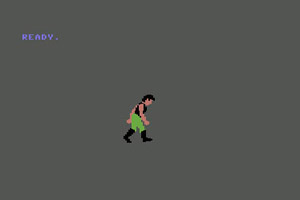
Psyclapse is one of the infamous Mega Game titles which Imagine Software were to release back in 1984. The series was to include around 6 games – with Psyclapse being the second title specifically being done on the C64 (Bandersnatch being the most well known and promoted on the ZX Spectrum platform).
Originally we only had the one entry for the entire Mega Games set, but to be honest – each game is worthy of its own entry. So we have the main Mega Games entry to cover all, and ones for each title that we know of which was due for the C64. The Mega Games entry in particular will talk more about the failed hardware add-on attempt to combat piracy. Here we will focus purely on the games themselves.
Psyclapse apparently got to the stage of a simple demo showing the hero walking while the walls of a castle scrolled behind him. The object of the game was apparently to escape from the castle where an evil villain had transported warriors from the past. Various descriptions in some sources described the main character with big boots and a slight arch – giving a game which was very like one of the Gargoyle adventure games.
The Sprite we managed to salvage from Stu Fotheringham’s disks must be indeed the main character – well, it is, as Eugene Evans confirmed that it was the game’s main character. Maybe Stoo Fotheringham was doing the graphics for this game? Anyway, check out the download and load “Print Nam” to see the sprite in its full glory. It seems odd though as Dawn Jones and Ally Noble were the two designers.
Interesting developments though with Psyclapse and with a particular disk that was found in the Mega Tree set of disks!… it could be very exciting news indeed! The disk is in the SAGE format which the games were being developed on, and recently a working SAGE machine was found – so the disk is now in the process of being read and extracted. It may only just contain graphics, but you just never know what will be found.
In the meantime, we have added some extracts from the Commercial Breaks documentary which we believe show some of the sprites and bits from Psyclapse. The graph paper shots are Ally Nobel’s work, which is believed to still be tucked away safely in an attic.
In 2015, packaging for Bandersnatch was recovered and sold at auction – but both the seller and buyer were very kind to scan in everything and make it available to all. Thanks also to Mark R Jones, we are proud to add the scenario details for Psyclapse which were within the box too.
Could we ever find anything playable for this game?
Contributions: Paul Drury, Stu Fotheringham, Eugene Evans, Mark R Jones, Ross Sillifant, Vinny Mainolfi, Peter Weighill
Supporting content
Available downloads
- Preview_Megagames (zip)
- pdf-megagames (zip)
Gallery
Creator speaks
Paul Drury speaks to Eugene Evans and asks some questions about the Mega Games, and Psyclapse in particular! (taken from RG109):
Megagames?
Lots of publishers had appeared, lots of bedroom programmers were cranking out games, lots of piracy was going on. We were getting WHSmith’s returning product to us and we were saying, wait a minute, this is professionally pirated. I don’t think the industry has been badly affected by individuals pirating games – the problem is when it’s done commercially en masse.
We had all sorts of crazy attempts to counter it. We had the Imagine printed on the clear plastic cassette leader tape, producing tapes that were different colours for different games – like Ah Diddums was yellow, Alchemist was gold.. .that was so we could identify pirate copies. Plus we felt we were reaching the limits of those home computers. I think it was Dave Lawson that said, what if we add some hardware which lets you do more and is also impossible to copy.
We employed an engineer called Steve Lavache, who I’m still in touch with, and he designed a prototype add-on that wasn’t just more memory, it was a ROM which you could put a game on.
Did they point at you and say “˜okay Eugene, make us a megagame!?
Well, there was a whole bunch of us. The year before we’d started making the transition from one guy doing pretty much everything, including desperately trying to draw the graphics, to us actually hiring artists. Previously, we hadn’t bothered employing musicians because what was the point if you hadn’t got the memory to include serious music in the game? Now we did have memory!
We were breaking the whole development model back then and hiring a load of people. Suddenly, these games had multiple artists, musicians, people doing sound effects, a couple of coders- it was a big switch! It foresaw what was coming. The future wasn’t going to be about one person producing a game, it was going to be about teams. The downside, and what really bit us, is that we didn’t understand that that needed planning.
Talked to Ally and John re: Bandersnatch -what progress on Psyclapse?
There was stuff on screen but it was not far along at all. I give credit to John and Ian with Bandersnatch -they were much further on and had big characters walking around on screen. We came up with different stories for each of the games, Bandersnatch and Psyclapse. It was very challenging. I don’t think we really understood the scope of what we were trying to do. We didn’t sit down and lay out a plan.
What was it going to be like?
We came up with the name first and tried to think of a plot to go with the name. It’s a bit of a stretch to remember but the basic storyline was there was a planet or place where someone was pulling from around the universe great warriors to this place where they had to fight and survive. We talked about Psyclapse as a “Psychological Collapse” believe it or not. That was the premise.
For both games, we had writers. That was a concept! We were going to get them to write a novel that would go in the box. Remember, we were all big fans of what was going on in the US. They were doing things on such a grander scale, probably because they had a bigger market to pursue. Think back to the Infocom games of that time [with lots of extra things in box]. Why were they doing that? One reason was piracy. They hoped that the real fans would want the whole experience – the box it comes in, the crazy manual, whatever gizmo was in the box.
I remember one came in a round plastic box shaped like a UFO, the hitch hikers guide came with a grand “don’t panic” button. We were looking at what they were doing and trying to emulate that. There was a whole lot of craziness on top of this piece of hardware that was going to cost money. We’re trying to figure out what that’s going to cost to manufacture and the cost keeps going up. One of the great scenes in Commercial Breaks is when our poor sales rep has to tell a buyer it’s going to cost £40, eight times more than a normal game.
Warriors in game – was it a beat em up/fighting game?
No, no. It was like Bandersnatch in that there was exploration and some combat. Essentially it was about these warriors trying to work out why they’d been brought there and how they could get back. Much more than that is either lost deep down in my mind or never figured out.
We had characters walking around. What both games had in common was characters 2 or 3 inches tall on the screen. A lot of games at the time had tiny characters. We were trying to consume all that memory we had planned to have access to by having really great quality animation. Again, we not only hired artists and designers, we hired animators.
Bailiffs? On loo?
It’s true! We were working on the games while things were falling apart. Ian and Dave had gone to the States to try and raise some money which I think was the right idea. It’s amazing to think at the time we were the number one publisher in the UK, Bruce has been quoted saying we were turning over a million a month which was a lot of money at the time, but we had failed to tap into the US market. Very few had.
We were starting to see companies like US Gold bringing games in from the States, competing with us, and they the advantage of licensing games, so had none of the risk of developing a game, employing programmers, working out if it was going to be any good. They would just bring over the top 5 games! I wonder how different the industry might have been if we’d gotten into the States earlier and said, okay how do we make games that the publishers over there are really going to want.
We were getting distracted by all these machines coming out -the Oric and the Amstrad the Dragon – all these machines were produced domestically and had no market in the US. If we could’ve gone after the huge US market, that whole period could’ve played out differently for a whole bunch of companies.
That day, the office was in a shambles. There was a lot of division, a lot of fear, a lot of concern – in parallel to the megagames we’d done this deal with Marshall Cavendish to produce a magazine about videogaming and have a cassette on the cover with a free game. This was a different way to combat piracy because if people liked the magazine, they’d subscribe and keep buying it for months. The short version is we hired a ton of people, it was very difficult to find experienced, talented people. We said we’d produce 10 games in a year, which was just crazy.
It’s not a reflection on those people – a lot of them went onto do great things- but in just 2 years we’d made this transition to one guy doing everything, to small teams, to 100 people trying to produce 10 games in a year that were actually good. When Marshall Cavendish saw the quality of the first games they said, we’re not doing this, we’re pulling out. Suddenly we’re left with far more staff than we need. We knew we were heading for bad times.
To their credit, the management really didn’t want to cut people, they saw it as a family, and finally it caught up with us. Everyone was in the pub one day – things were generally lax as we were all afraid of where things were heading and the next ting someone whispers in my ear, you better get upstairs, the bailiffs are here. We ran upstairs to discover the bailiffs and local sheriff had turned up, were locking the doors and taking inventory.
John Gibson and I saw what was going on and got it into our heads we wanted to continue with the megagames, so we grabbed as many of the development machines as we could, took them to the bathrooms, put them on the toilets and locked the doors, then crawled underneath. We didn’t see it as stealing. We had the best intentions in the world – we wanted to finish those games. We needed to grab that stuff and work out how to continue working on them.
We did set up at Dave Lawson’s house but then we went to a bankruptcy hearing with maybe 50 0r 60 people there and at the end, they rattled off a list of people they wanted to keep behind. Me, John and a number of other people stayed around and a nice lady walked up and said “are you Eugene Richard Evans” and I now know if anyone ever does that, say no. She handed me an envelope that said they believed I had assets of imagine software in my possession and if I didn’t hand them over, they would take action.
What happened?
Everything was at Dave Lawson’s place in the Wirral. We were still driving around in some of the cars we had from Imagine and one day some nice gentlemen who clearly looked like could look after themselves, came to repossess them. We were happy to hand them over. They’d been so polite.
Give computers back? Did you copy disks first?
I think the statues of limitations mean I’m now safe to say of course we copied them! We were starting to negotiate for the rights [to the megagames] They had rows and rows of computer equipment they wanted to sell off and if that happened, the code would be gone. In the end, we did get the rights to Bandersnatch which became Braatacus for the ST and Amiga from Psygnosis.
Did the Psyclapse code get in there?
It was really just the thinking. Sinclair were about to come out with the QL and we realised we didn’t need any extra fancy hardware but the thinking was right. Here’s a machine that’s going to have enough memory, it has this crazy drive we can put a big game on and Sinclair might actually be willing to fund this. The plan was to do it for the QL. That machine ended up being a complete failure but it did get us up to speed on that processor [68000 – check] and Dave, who I think was the principle coder, moved it onto the ST and Amiga, where it eventually came out as Brattacus.
Update history
- 15/06/25 – Added more screens from the hi-res BBC release of Commercial Breaks
- 17/09/24 – Additional scan added thanks to Vinny Mainolfi
- 07/10/15 – Psyclapse scenario notes added thanks to Mark R Jones
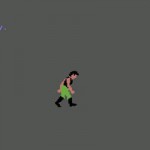





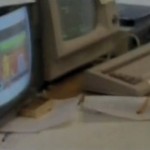


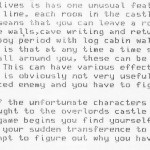
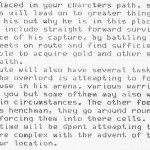


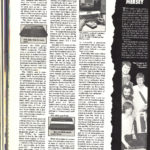
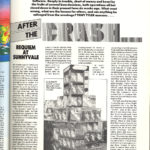


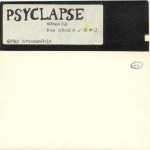

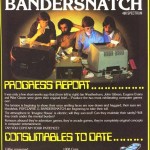
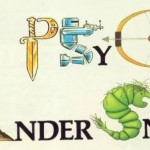
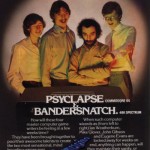
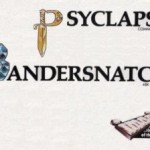
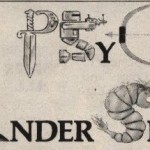


Ian Hetherington has been quoted as saying the thinking behind Bandersnatch and Psyclapse helped to form Brattacus.. Particularly the idea of not compromising the design just to make the coding easier..they still ended up with a 4 colour Amiga game, with unpopular mouse control,but in his view, it showed the way forward.
Ah I see .. I wonder if they re-used a lot of the characters created across both in the Brattacus game. Might have to compare the design docs to the game to see what may have been put across.
Company called Finchspeed doing the QL version?
ST Brattacus was awful
All that you had to do was to be nifty with your sword, find the two pieces
of evidence, and return to the transport tube that you arrived at and leave,basically.
The animation on the ST also got bit
slow when there were lot of objects and people moving.
Game was poorly received and sold badly.
Would have just been Bandersnatch that Finchspeed were doing Ross. I don’t think Psyclapse got picked up by them, but would be cool if they did start something!
Post from Stuart James Fotheringham Psyclapse was a C-64 “mega-game” by Imagine, but only really existed on
paper before the company went bust. The only demo had the hero, wearing
knee-high black boots, stomping along — he was fixed in the centre of the
screen (like Tir Na Nog) and a stoney wall background scrolled left and
right. The hero was actually quite large by 1984 standards, using mutiple
raster sprites. The story was about an evil villain who had transported
warriors from throughout time to his fortress castle on a secret island, the
object of the game was to escape.
Imagine’s second C-64 “mega-game” was an Atari Star Raiders clone.
After all this time, two different versions of Bandersnatch for the Sinclair QL have been found – one version uses low resolution graphics (in 8 colours) and is unfortunately, so corrupt that it crashes on the first screen (despite attempts to rescue the data from the microdrive cartridges.
Another version has now been almost fully recovered (in 2017) and forms a playable version with a few bugs, which has a look much more like the program Brataccas which was eventually released for the Atari ST and Commodore Amiga. Unfortunately, the QL version appears to lack any objects or people to interact with, so it is unclear whether this is due to corrupt sectors on the microdrive cartridges or an unfinished program.
More details, including screenshots appear on the QL Forums – http://www.qlforum.co.uk/viewtopic.php?f=3&t=2033
That is awesome news Rich! Thanks for sharing! The lower resolution one seems to be more close to the original Spectrum game perhaps?